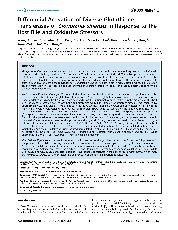摘要
Background: Clonorchis sinensis causes chronic cumulative infections in the human hepatobiliary tract and is intimately associated with cholangiocarcinoma. Approximately 35 million people are infected and 600 million people are at risk of infections worldwide. C. sinensis excretory-secretory products (ESP) constitute the first-line effector system affecting the host-parasite interrelationship by interacting with bile fluids and ductal epithelium. However, the secretory behavior of C. sinensis in an environment close to natural host conditions is unclear. C. sinensis differs from Fasciola hepatica in migration to, and maturation in, the hepatic bile duct, implying that protein profile of the ESP of these two trematodes might be different from each other. %26lt;br%26gt;Methodology/Principal Findings: We conducted systemic approaches to analyze the C. sinensis ESP proteome and the biological reactivity of C. sinensis glutathione transferases (GSTs), such as global expression patterns and induction profiles under oxidative stress and host bile. When we observed ex host excretion behavior of C. sinensis in the presence of 10% host bile, the global proteome pattern was not significantly altered, but the amount of secretory proteins was increased by approximately 3.5-fold. Bioactive molecules secreted by C. sinensis revealed universal/unique features in relation to its intraluminal hydrophobic residing niche. A total of 38 protein spots identified abundantly included enzymes involved in glucose metabolism (11 spots, 28.9%) and diverse-classes of glutathione transferases (GSTs; 10 spots, 26.3%). Cathepsin L/F (four spots, 10.5%) and transporter molecules (three spots, 7.9%) were also recognized. The universal secretory proteins found in other parasites, such as several enzymes involved in glucose metabolism and oxygen transporters, were commonly detected. C. sinensis secreted less cysteine proteases and fatty acid binding proteins compared to other tissue-invading or intravascular trematodes. Interestingly, secretion of a 28 kDa sigma-class GST (Cs28 sigma GST3) was significantly affected by the host bile, involving reduced secretion of the 28 kDa species and augmented secretion of Cs28 sigma GST3-related high-molecular-weight 85 kDa protein. Oxidative stressors induced upregulated secretion of 28 kDa Cs28 sigma GST3, but not an 85 kDa species. A secretory 26 kDa mu-class GST (Cs26 mu GST2) was increased upon treatment with oxidative stressors and bile juice, while another 28 kDa sigma-class GST (Cs28 sigma GST1) showed negligible responses. %26lt;br%26gt;Conclusions/Significance: Our results represent the first analysis of the genuine nature of the C. sinensis ESP proteome in the presence of host bile mimicking the natural host environments. The behavioral patterns of migration and maturation of C. sinensis in the bile ducts might contribute to the secretion of copious amounts of diverse GSTs, but a smaller quantity and fewer kinds of cysteine proteases. The Cs28 sigma GST1 and its paralog(s) detoxify endogenous oxidative molecules, while Cs28 sigma GST3 and Cs26 mu GST2 conjugate xenobiotics/hydrophobic substances in the extracellular environments, which imply that diverse C. sinensis GSTs might have evolved for each of the multiple specialized functions.
- 出版日期2013-5
